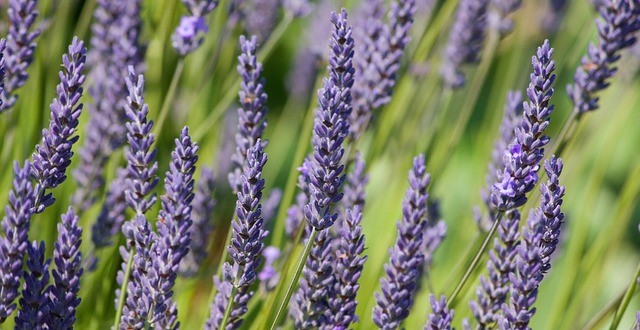English Lavender (Lavandula angustifolia) is easy to grow in Sunnyvale gardens. It has modest water needs and can grow in small areas (once established). My lavender plant is in a two-foot wide trench excavated one foot deep in clay.
Fresh lavender flowers may be used in sauces, marinades, and desserts. Handle fragile dried blossoms with care and use them in teas, salts, potpourri, sachets, and crafts. Hang lavender blossoms upside down to dry them.
You can dry lavender easily by tying the cut stems in clumps to hang upside-down away from direct sunlight.
Soil, Planting, and Care
Set out plants 12 to 18 inches apart in an open area with full sun and good air circulation. Plant lavender in well-drained, slightly alkaline soil with a pH between 6.7 and 7.3. You can add builder’s sand to the soil before planting to increase drainage, which is vital because lavender will not tolerate excessive soil moisture or humidity. To further improve drainage, plant lavender in a raised bed, along a wall, or near the top of a slope. In an herb or perennial bed, ensure good drainage by planting lavender on a small mound. Lavender flowers bloom in summer; you can clip faded blooms to encourage continued blooming throughout the warm season. Prune lightly to promote branching, especially in spring once the plants show new growth.
Sprinkle bone meal or other phosphorus-rich fertilizer around each plant in the fall to make it stronger and more winter hardy. Work the fertilizer into the first inch of soil, or let the rain soak it in
Troubleshooting
Plant lavender transplants in a pot to start them growing right with well draining soil.
Start your plants in pretty containers, especially in humid climates where good air circulation is a must.
Remember that lavender needs good drainage and good air circulation. Do not over-water, and allow the soil to dry before watering again. When there is a lot of heat and humidity, fungus can attack the plants, turning the leaves brown. To minimize the chance of having such a problem, mulch with pebbles or sprinkle sand around the base of the plant for faster evaporation. If you cut the blooms, trim in a way that thins the plant a bit, leaving it open for better air circulation.
Harvest and Storage
Cut lavender flowers with a long stem attached.
When you cut lavender blossoms, leave a long stem attached for handling.
Harvest lavender stems at any time by cutting them from the plant. However, avoid clipping more than every third stem to keep the plant looking full. Flowers will keep their perfume for months when you harvest just before they are entirely open. To dry flowers, gather a bunch of stems and hang them upside-down in a dark, well-ventilated place to preserve color and keep the stems from molding.
Details
Lavandula angustifolia
Family: Lamiaceae (lay-mee-AY-see-ee) (Info)
Genus: Lavandula (lav-AN-dew-lah) (Info)
Species: angustifolia (an-gus-tee-FOH-lee-uh) (Info)
Synonym:Lavandula officinalis
Synonym:Lavandula spica
Synonym:Lavandula vera
Category:
Herbs
Height:
12-18 in. (30-45 cm)
Spacing:
18-24 in. (45-60 cm)
Hardiness:
USDA Zone 5a: to -28.8 °C (-20 °F)
USDA Zone 5b: to -26.1 °C (-15 °F)
USDA Zone 6a: to -23.3 °C (-10 °F)
USDA Zone 6b: to -20.5 °C (-5 °F)
USDA Zone 7a: to -17.7 °C (0 °F)
USDA Zone 7b: to -14.9 °C (5 °F)
USDA Zone 8a: to -12.2 °C (10 °F)
USDA Zone 8b: to -9.4 °C (15 °F)
USDA Zone 9a: to -6.6 °C (20 °F)
USDA Zone 9b: to -3.8 °C (25 °F)
Sun Exposure:
Sun to Partial Shade
Danger:
Pollen may cause allergic reaction
Bloom Color:
Violet/Lavender
Purple
White/Near White
Bloom Time:
Mid Summer
Late Summer/Early Fall
Foliage:
Evergreen
Silver/Gray
Aromatic
Other details:
This plant is attractive to bees, butterflies and/or birds
Flowers are fragrant
Average Water Needs; Water regularly; do not overwater
Soil pH requirements:
6.1 to 6.5 (mildly acidic)
6.6 to 7.5 (neutral)
7.6 to 7.8 (mildly alkaline)
Patent Information:
Non-patented
Propagation Methods:
From softwood cuttings
From semi-hardwood cuttings
From seed; sow indoors before last frost
Seed Collecting:
Allow seedheads to dry on plants; remove and collect seeds
Read more: http://davesgarden.com/guides/pf/go/289/#ixzz3OZL0832V








